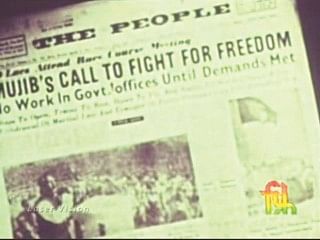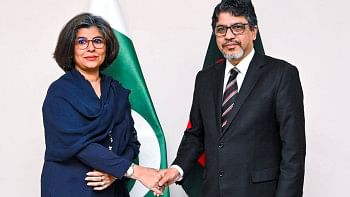9 Months To Freedom
 The documentary is a treasure trove of rare footage and interviews.
The documentary is a treasure trove of rare footage and interviews.
Even after four decades of independence, many of us do not know the true stories surrounding the Liberation War, the facts about the war and the woeful plight of hundreds of thousands of people who fled their homes during the nine-month war. Films and documentaries have always been a good source of history and in the case of a sensitive issue like the Liberation War, original video footage are sometimes much more powerful than written words in recounting the truth.
There are a number of documentaries on the Liberation War, but many of them were not shot during the war. Indian filmmaker S. Sukhdev's “9 Months To Freedom,” is a visual document of our struggles to emerge as an independent nation, and an account of the loss that we incurred during that period.
 The documentary is a treasure trove of rare footage and interviews.
The documentary is a treasure trove of rare footage and interviews.
Shot in 1971, it is a treasure trove of rare footage and interviews that are indispensable parts of history. Sukhdev walked from one camp to another to record his film and watched closely the agonies of Bangladeshis, and the brutality of the Pakistani military. It mainly depicts the miserable lives of refugees; shows how people died inside and outside camps. It narrates how villages were burnt, how unarmed people were shot dead, how people died without food and how they walked thousands of miles to reach a refugee camp.
Sukhdev had to work inside the liberated areas or the areas that were under Mukti Bahini's control, as foreign journalists.
In the opening scene, a government officer of then East Pakistan says “What's happening with the people of my country is totally unknown to the rest of the world. “The documentary also contains interviews of Ayub Khan, Sheikh Mujibur Rahman, Tajuddin Ahmed, Zahir Raihan, and many others. In this documentary we see veteran Frenchman Andre Malraux saying, “If necessary I will take up arms and fight for the people.”
Sukhdev portrayed the conflict between the two wings of Pakistans that emerged in 1947. The Language Movement, Ayub Khan's martial law, Agartala conspiracy case, 1970 general election -- all these historical moments were combined effectively in this work.
Powerful visuals with touching interpretations have made this documentary a powerful one; it is one the few films that remind us of the nine months of struggle. Apart from only visualizing the war, it shows the deplorable conditions of hundreds of thousands of families, the response of the international community, and reactions of the Pakistani rulers. In this documentary, we see horrific footage of December 14 taken by Zahir Raihan. It ends with our victory scene in sync with a 1971 version of the national anthem.
The documentary promises to enlighten the new generation who seek an authentic account of our history. The Bangla version of this documentary is available at the Liberation War Museum; Laser Vision has also released this documentary.

 For all latest news, follow The Daily Star's Google News channel.
For all latest news, follow The Daily Star's Google News channel. 



Comments